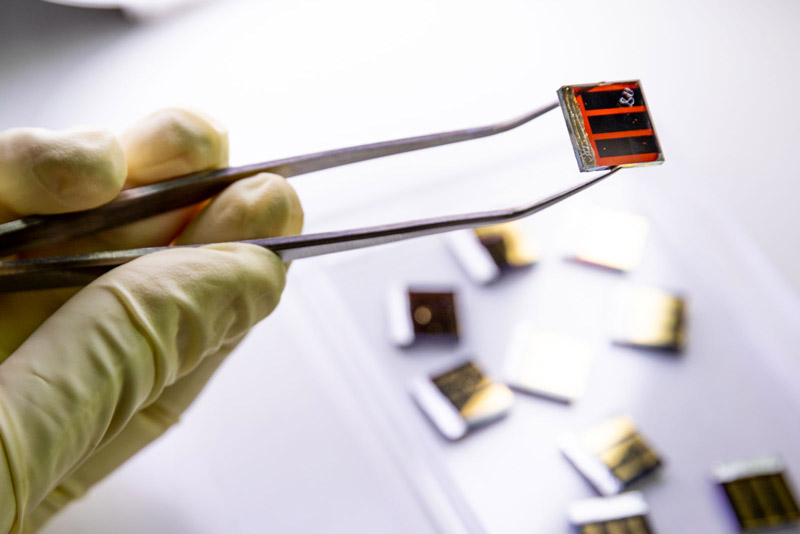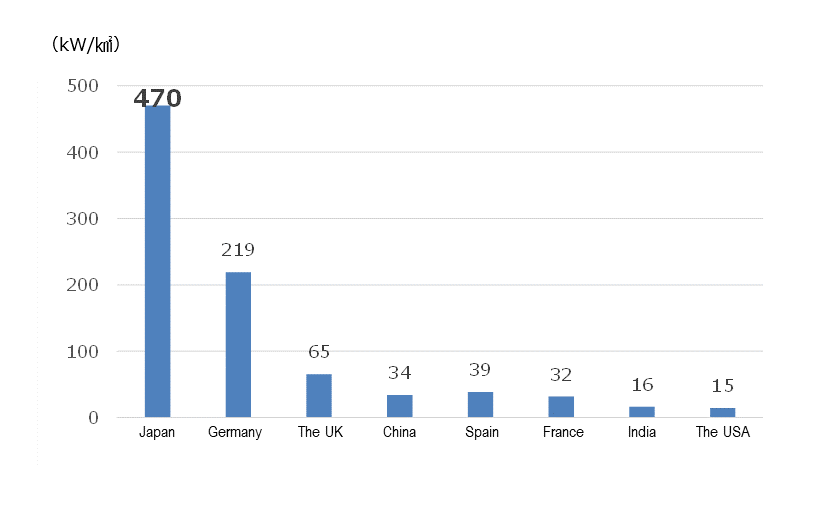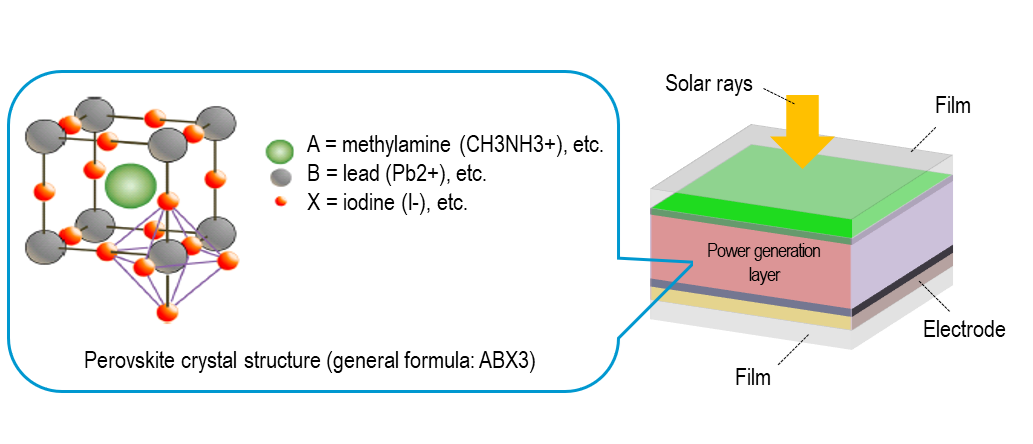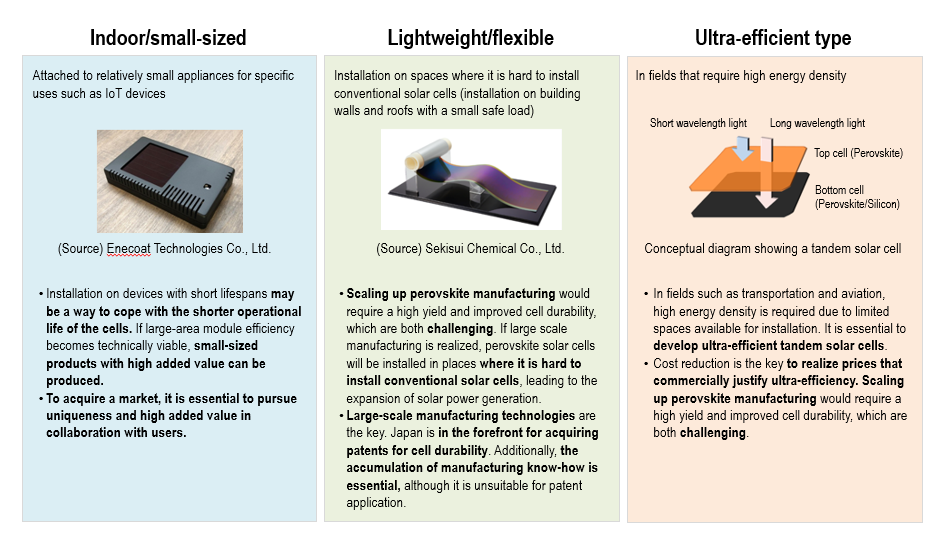Perovskite Solar Cells: The Key to the Future Expansion of Renewable Energy in Japan.
Part 1: Differences from Conventional Solar Cells
(Provisional translation)
(English ver.) 2024-05-31

(Source) The National Institute of Advanced Industrial Science and Technology (AIST)
It is essential to expand renewable energy toward achieving carbon neutrality by 2050. Due to the scarcity of suitable terrain for the installation of photovoltaic generation facilities in Japan, perovskite solar cells are attracting attention to further expand the introduction of renewable energy. The Government of Japan supports research and development of this next-generation solar technology. This article (in two parts) presents everything you need to know about perovskite solar cells.
A promising technology to accelerate the introduction of photovoltaic power generation
The words “solar cells” may convey the image of large solar panels covering a vast area or being installed on building roofs. Most of these are so-called silicon-based solar cells with the power generation layers made of silicon. This type of solar cell is currently the most popular type, with a dominant market share of 95%.
Silicon-based solar cells demonstrate high power conversion efficiency (PCE) with excellent durability. However, both the batteries themselves and the glass to increase cell durability outdoors are heavy. This means there are limited spaces available for new installation. As the graph below indicates, Japan ranks the first among major nations in terms of solar power generation capacity per square kilometer of flatland. Therefore, it is a critical challenge to secure suitable spaces for further installation.
Solar power generation capacity per square kilometer of flatland

(Source) Created by ANRE based on the Ministry of Foreign Affairs website (https://www.mofa.go.jp/mofaj/area/index.html), Global Forest Resources Assessment 2020(http://www.fao.org/3/ca9825en/CA9825EN.pdf), IEA Market Report Series - Renewables2020 (Electricity generated by respective countries in 2019), the Comprehensive Energy Statistics (FY2020 final figures), FIT-certified capacities, and other information
Perovskite solar cells are in the spotlight as a solar power technology that could overcome this challenge. Unlike silicon-based solar cells, perovskite solar cells are thin, light and flexible. This allows them to be introduced on spaces where it is hard to install conventional solar cells.
Light and flexible solar cells with the primary material iodine produced domestically
What, then, are the characteristics of perovskite solar cells that differ from those of silicon-based solar cells?
The name “perovskite” comes from the nickname for their crystal structure as described below. Perovskite solar cells use the chemical compound of this structure as power generation layers and have a number of characteristics described below.
1) Anticipated cost reduction
Perovskite solar cells can be produced with the materials painted or printed on a film. Therefore, they can be mass-produced in a small number of production processes, and cost reduction is anticipated.
2) Light and flexible
Unlike silicon-based solar cells which are heavy and thick, perovskite solar cells form a membrane of the mass of small crystals, and are light and resilient to bending or distortion.
3) Japan boasts the second largest global share for the production of the main material
The primary material for producing perovskite solar cells is iodine, and Japan has the second largest share (about 30%) of its global production. (The world’s largest producer is Chile with a 60% share.) Accordingly, Japan will be able to build an independent supply chain for a stable supply, which is an advantage in terms of economic security.
Despite the many advantages described above, a number of challenges remain before perovskite solar cells can become a competitive commercial technology. Some of those challenges are their short lifespan due to poor cell durability, and difficulty in deploying them in a large area. Increasing the power conversion efficiency (PCE) is also an issue. In recent years, they have demonstrated a PCE with higher performance, which could potentially compete with silicon-based solar cells. Going forward, it is necessary to further increase the PCE.
Various applications to create markets
Perovskite solar cells are expected to create various markets depending on their uses and purposes.
For instance, lightweight, flexible perovskite solar cells can be installed on building walls and factory roofs with a small tolerable load, which will increase the introduction of solar power generation. A certain level of progress has already been made in the development of such solar cells. Going forward, manufacturing technologies toward mass production must be developed. In addition, building a supply chain and creating initial demand are the key.
Indoor/small-sized perovskite solar cells can be attached to relatively small appliances such as IoT devices. They are also expected to create new markets.
Furthermore, ultra-efficient tandem type perovskite solar cells are expected to be utilized in fields such as transportation and aviation, which require high energy density due to limited spaces available for installation. Scaling up ultra-efficient perovskite manufacturing would require cost reduction and improved cell durability, which are both challenging. However, market expectations for these products will be high in the future.
In recent years, intense competition for the development of perovskite solar cells has been seen across the world. Japan is in the forefront in the technological development of this technology and also leads the world in developing larger-sized cells with improved durability, which is essential for manufacturing commercial products. Part 2 of this article will present situations in other countries regarding the development of perovskite solar cells and efforts being made by Japanese companies.
Divisions in Charge
About this article
New and Renewable Energy Division, Energy Efficiency and Renewable Energy Department, ANRE
About the Special Contents
Research and Public Relations Office, Commissioner’s Secretariat, ANRE
![]() The original Japanese text of this article; Click here
The original Japanese text of this article; Click here

